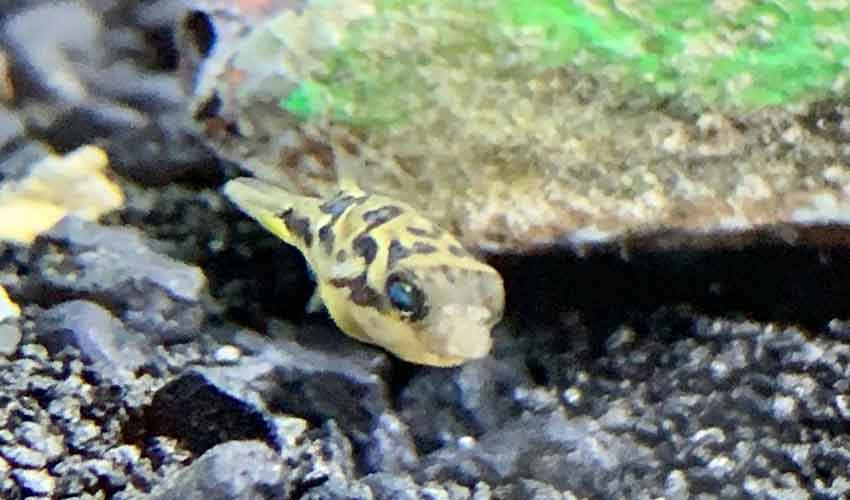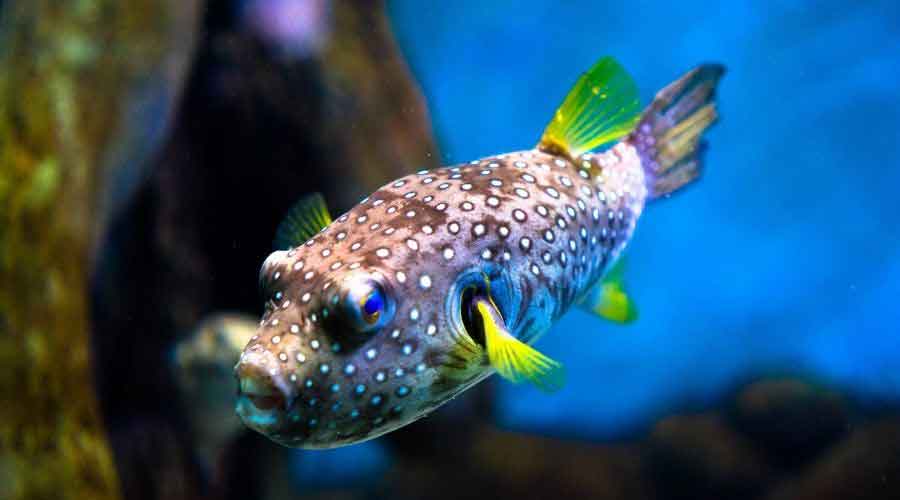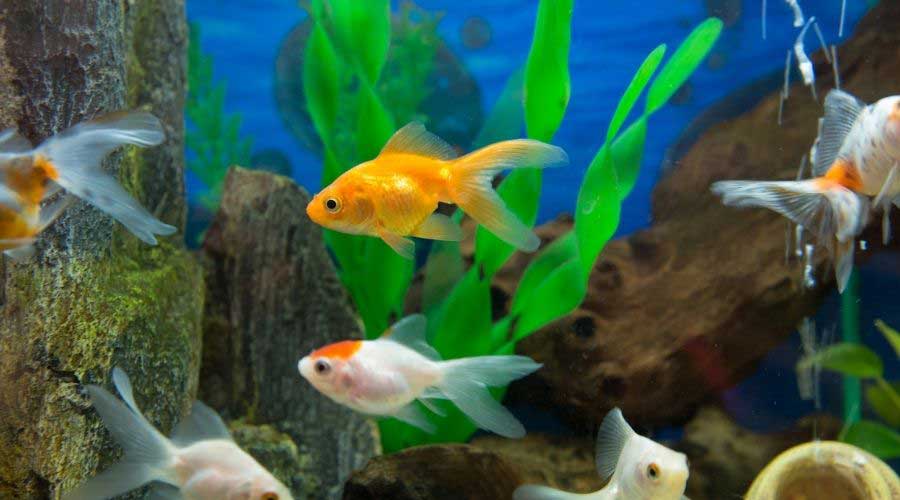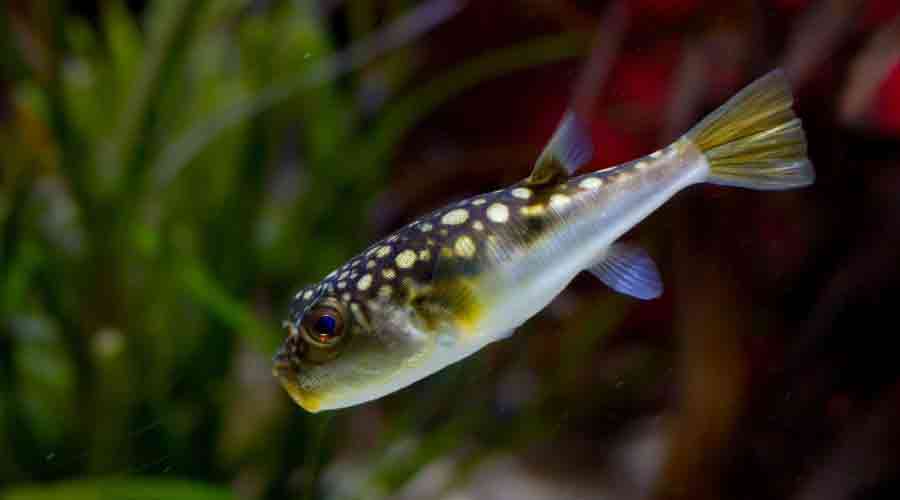In this blog, I’ll discuss pea puffers, also known as the Malabar puffer fish. This is a very unique fish for freshwater tanks. And actually, it’s one of my favorites, primarily because it’s just so different. I mean, it’s a one-inch fish that has the potential to inflate, hover up and down like a helicopter and move its eyes independently of one another.
| Quick Facts | |
|---|---|
| Origin: | India |
| Lifespan: | 4 years |
| Minimum Tank Size: | 10-gallons (recommended) |
| Temperament: | Can be aggressive and territorial |
| Food: | Frozen blood worms, frozen brine shrimp |
| Poisonous: | Don't eat them and you're fine. |
About Pea Puffers
The world’s smallest puffer fish, pea puffers (Carinotetraodon travancoricus) are unique in appearance, inquisitive, and engaging in behavior and temperament and they live approximately four years, altogether making them popular as pets.
The pea puffer is also known as the dwarf puffer fish, Indian dwarf puffer, pygmy pufferfish, and pea pufferfish. So, in short (that was kind of a pun), just by looking at the different names, you can tell these guys are pretty small.
Origin
In nature, you’ll find the pea puffer fish in the lakes, rivers, estuaries, and other freshwaters in India’s southwestern tip. Although they are not considered brackish fish, they often frequent the lightly brackish waters of the estuaries in their natural environment. Do not try to recreate a brackish environment for your pea puffers, however, as this will only shorten their lifespan. I’m trying not to point out the pun in that last sentence.
Whatever waters they choose, Malabar puffers prefer the more heavily planted areas, such as river banks, still waters, and areas of low flow, where plenty of plant life exists to protect them from predators and the current while they scavenge for food and breed (more on this later).
In their native environment, pea puffers get about 12 hours per day of sunlight during the summer and about 10.5 hours per day during the winter.
Appearance

Lending to its many names connoting smallness, the pea puffer grows to only about one inch in length and a maximum of 1.4 inches. So yeah, it’s a pretty small fish. Contrasting its small body are its large eyes that move independently of one another. This is a pretty interesting feature of this little fish.
Pygmy puffers are colorful fish, generally yellow with dark patches. They also have the ability to change color and, most notably, blow themselves up like miniature water balloons.
Telling the difference between male and female dwarf puffers can be challenging. As is common among fish species, the males tend to have deeper colors. Both male and female pygmy puffers have a greenish tint to their coloration, but males have a darker golden hue. Female dwarf puffers, by contrast, have a light yellow hue, except for their bellies, which tend to be less yellow than the males.
Males may also have a dot or stripe on their belly, usually a dark, thick stripe running between their pectoral and caudal fins. Male pea puffers tend to be more slender than females, who tend to be plumper. Females can also have small black spots randomly dotting their bodies all over. They also don’t have wrinkles around their eyes as males do.
The Behavior and Temperament of Pea Puffers
Behavior
The pea puffer is renowned for its helicopter-like ability to maneuver around obstacles and through tight spaces. This can be pretty fascinating to watch.
As for its ability to inflate itself into a big ball, be aware that you probably won’t see your pea puffer do this very often, especially if you’re taking care of it right and keeping it from fright or stress.
This ability of the pea puffer is a defense mechanism. The last thing you want to do, certainly, is to scare or stress your fish simply to make it inflate. If your pea puffer does, at some point inflate, rest assured, it will deflate in time, after the perceived threat or stressor has dissipated.
Pro tip: don’t go banging on the glass of your aquarium to try and make your pea puffer inflate.
The pea puffer inflates by sucking in water to enlarge its appearance. Therefore, if you have to move your pea puffer, use a small container or cup rather than a net so it doesn’t inadvertently suck in the air.
Temperament
While some pea puffer fish can be more mild-mannered, the general temperament of dwarf puffers tends to be more territorial and aggressive. Despite this, however, they are not solitary fish. Rather, they are quite social and live in big shoals.
Males, in particular, tend to show more aggressive behavior than females, who tend to be more passive and, in cases, even timid. Whatever their behavior toward other dwarf puffers and other species of fish may be, however, dwarf puffers can learn to recognize the person feeding and keeping them, and will often greet their owners each feeding time.
Pea Puffers and Their Tank: Aquarium Requirements

Keep dwarf puffer fish in a heavily-planted tropical freshwater aquarium meeting the following guidelines:
Tank Size
As their name implies, pea puffer fish are perfectly suitable for smaller aquariums. The general rule-of-thumb with dwarf puffer fish is to give each one about five gallons of space to itself. The pea puffer is a highly territorial fish. So, if you plan to have more than one pea puffer in a single tank, be sure to allow at least five gallons to each pea puffer. You can probably get away with two dwarf puffers in a 10-gallon tank and about five pea puffers in a 20-gallon.
To help avoid hostility between multiple dwarf puffers in a single tank, be sure to add plenty of lush, dense plant cover between them. More than one pea puffer in a wide-open aquarium is simply asking for a showdown. You can also reduce the chances of aggression among your dwarf puffers by having two or three females for every one male. When you have more than one male in a tank, they can become aggressive and territorial toward each other, particularly during breeding periods.
Of course, since dwarf puffers are commonly sold while still young, it can be hard to determine their gender prior to purchase. If you buy several dwarf puffers and later find that you have more males than females, you may have to rehome as many of the males as it would take to bring your ratio of males to females to a suitable level.
These numbers assume, of course, that there are no other fish in the tank. If your dwarf puffer fish are to have tankmates, you will not be able to keep as many in the same size tank. Additionally, while these numbers represent the minimum recommended criteria, the larger the aquarium, the better for any number of Malabar puffers.
Substrate
Use small-particle gravel or coarse sand as your substrate in order to promote the root growth of all the live plants in the tank. Because dwarf puffers are such messy eaters, you’ll need to clean the substrate in the tank weekly with a gravel vacuum to take out parasitic spores and uneaten food.
Having plenty of live plants in the tank will help reduce aggression and hostility and give your fish a more familiar, naturalistic, and therefore lower-stress environment. It will also promote breeding and provide your fish with ample dissolved oxygen to promote healthy respiratory activity. Recommended live plants for an aquarium with pygmy puffers include:
- Anubias Nana
- Java Moss
- Stargrass
Consider purchasing a pair of scissors and long, aquascape tweezers to help you plant and arrange new plants once your fish already populate the fish tank. It makes things much easier.
Water Temperature
Malabar puffers, or pea puffer fish, thrive in an environment ranging between 74 and 82 degrees Fahrenheit. Therefore, depending on the room temperature where your aquarium is located, you may or may not want to install a heater. If the temperature of the room is usually below this range or tends to fluctuate significantly, a heater may be wise.
If the temperature level drops too low in the tank, the immune system of your dwarf puffers can drop as well, exposing them to the risk of diseases like white spot disease, or Ich infection.
pH
The ideal pH range for dwarf puffer fish is from 7.2 to 7.5, although pea puffers have done fine in tanks with pH levels ranging from 6.5 to 8.4. More important for dwarf puffers than keeping the pH in their tank at a particular number is simply keeping the levels stable and consistent, whatever the number.
Filter
Malabar puffer fish are relatively slow swimmers compared to other aquarium fish their size. Therefore, use a filter that has a slower flow rate, as it will be safer for your puffers. If your filter has an adjustable water outlet, make sure to point it toward the rear of your aquarium so as to minimize the flow it produces.
Malabar puffers can be messy eaters, so supplementing your filter with a decent amount of live aquarium plants in your tank can also help keep it clean, but of course, always remember to do those regular water changes.
Additionally, some keepers of pea puffers prefer sponge filters.
Tank Mates for Pea Puffers

Because of the potentially aggressive temperament of dwarf puffers, many tropical fish experts recommend keeping them in a tank by themselves.
If you are planning to place other freshwater fish in the same tank with dwarf puffers, plan for the possibility that your dwarf puffers may become aggressive, and be prepared to separate any fish from your dwarf puffers if one starts attacking the other. They may even attack algae eaters and other fish known to help keep tanks clean, putting more of the responsibility on you to maintain your tank and keep it clean.
In the wild, dwarf puffers can be found in the same water systems as:
- Filament Barbs
- Long-finned Barbs
- Malabar Leaf Fish
- Orange Chromide
- Paral Fish
One way to lessen the chances of a problem between your dwarf puffers and other fish you place in the same tank is to choose fish that are larger than the dwarf puffers. Then, the dwarf puffers may not feel so inclined to behave aggressively toward them. Just be sure you don’t pick an aggressive species like large catfish that will turn around and attack your dwarf puffers.
Another way to keep dwarf puffers in a community tank is to put them with smaller, faster swimmers like:
- Dwarf Otocinclus
- Ember Tetras
- Glowlight Tetra
- Harlequin Rasbora
- Leopard Danio
- Mosquito Rasbora
- Neon Tetras
- Siamese Algae Eaters
- Zebra Danio
Also, freshwater fish like rainbow sharks and red-tail sharks can work well in a tank with pea puffers. They are moderately aggressive fish that can hold their own. Plus, they grow to be around six inches long. But, make sure your tank is plenty big. I’d suggest 55 gallons if you are keeping a rainbow shark.
Avoid keeping Malabar puffers with shrimp, small snails, or slow-swimming, large-finned fish like guppies. They will most likely get harassed.
If you do have more than one dwarf puffer in your tank or any other fish with your dwarf puffer, keep a supply of antibacterial and antifungal treatment and fish antibiotics handy in case a dwarf puffer becomes aggressive and nips a chunk out of another fish.
Keeping Pea Puffers
Dwarf puffer fish are not recommended for all tropical fish owners. This is not exactly a fish for beginners. Beginners might find their tank requirements, aggressive temperament, and special diet too cumbersome. If you do decide to keep Malabar puffer fish, choose ones with a healthy appearance, including a decently plump belly, and a vigorous demeanor.
In addition, be sure to purchase your pygmy puffers from a reputable fish store or dealer, as the overharvesting of pygmy puffer fish in the wild has led them to become listed as a species vulnerable to extinction.
Pea Puffer Food: Diet and Feeding
Malabar puffer fish can be finicky eaters, so ask whoever sells you the fish what they are currently eating. Then, continue feeding your fish the same food it’s used to until you find out what else your particular pea puffer likes.
In the wild, pygmy puffer fish eat microscopic algae, water fleas, copepods, larvae, and insects. In an aquarium, dwarf puffers generally enjoy live fish foods like blackworms, cyclops, and pest snails, and frozen fish foods like brine shrimp and bloodworms (they love these things).
Most dwarf puffers will ignore dry food. You can also add an algae wafer to their tank every once in a while, though it may or may not get eaten.
Pygmy puffers are avid scavengers and can be found in all corners of the tank voraciously scavenging for any missed food. It’s best to feed them twice each day, once in the morning and once in the evening.
When feeding your dwarf puffers, watch them to see how long it takes them to eat most of the food you’ve provided. They should consume most of it within three minutes of feeding. Once you’ve found the right amount to feed your fish, be consistent in feeding them this amount and no more each time, even if your fish act like they’re still hungry. Overfeeding can cause nitrate levels in the aquarium to spike, leading to excessive, undesirable algae growth, which can make your tank nasty and unhealthy for your fish.
Breeding Pea Puffer Fish
When breeding dwarf puffers, place one male and three females in a tank at least 20 gallons in size. Unlike other fish, breeding pea puffer fish isn’t exactly all that hard. The males usually just chase the females around until the female decides to go along with the male. Usually, they will mate away from the other fish in your tank, behind plants, or in a hideout.
Are Pea Puffers Poisonous?
In short, pea puffer fish would only harm you if you ate them. Typically, pea puffers aren’t nearly as poisonous as other puffer fish you find in the wild. This is because they are not exposed to certain types of algae and bacteria that are found in the wild. Don’t eat your pea puffers and you’ll be fine.
Pea Puffers: A Recap
The pea puffer or dwarf puffer fish is a pretty interesting fish as we’ve seen in this blog. It’s a tiny fish from India that’s pretty colorful and a bit odd, if we are being honest. But, all of these things make it a very intriguing fish for many fish keepers.
It can be fascinating to watch, has several unusual characteristics, and can be quite aggressive. For this reason, it’s not recommended that pea puffers be placed in fish tanks with just any type of fish as it could create a problem.
These dwarf puffer fish are finicky eaters, but unlike a lot of fish are pretty easy to breed.
If you plan on getting pea puffers, always consider the size of your tank, and the other fish you are or will be keeping with your pea puffer fish.
Our Recommendations:


Pea Puffers are totally cool In many ways! They are definitely an interesting fish, but they can be way too aggressive with other fish. It just depends I guess!
Yes, you definitely have to keep them with the right types of fish. Just going by their size, you might not think a fish as small as the dwarf puffer would be so aggressive. LOL.